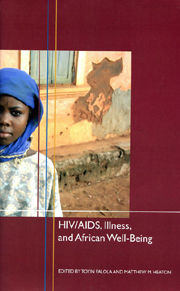Book contents
- Frontmatter
- Contents
- Acknowledgments
- Part I Context
- Part II Illness Case Studies
- 2 Waterborne Diseases and Urban Water Supply in Makurdi, Nigeria, 1927–60
- 3 Smallpox and Social Control in Colonial Saint-Louis-du-Senegal, 1850–1916
- 4 Poor Man's Trouble, Rich Man's Graveyard: A Study of Malaria and Epidemiological Sciences since the Nineteenth Century
- 5 Perceptions of Epilepsy in a Traditional Society: An Akan (Ghana) Family's Experience
- 6 Disability in Nigeria
- Part III Globalization, Development, and Health
- Part IV HIV/AIDS
- List of Contributors
- Index
- Rochester Studies in African History and the Diaspora
4 - Poor Man's Trouble, Rich Man's Graveyard: A Study of Malaria and Epidemiological Sciences since the Nineteenth Century
from Part II - Illness Case Studies
Published online by Cambridge University Press: 05 February 2013
- Frontmatter
- Contents
- Acknowledgments
- Part I Context
- Part II Illness Case Studies
- 2 Waterborne Diseases and Urban Water Supply in Makurdi, Nigeria, 1927–60
- 3 Smallpox and Social Control in Colonial Saint-Louis-du-Senegal, 1850–1916
- 4 Poor Man's Trouble, Rich Man's Graveyard: A Study of Malaria and Epidemiological Sciences since the Nineteenth Century
- 5 Perceptions of Epilepsy in a Traditional Society: An Akan (Ghana) Family's Experience
- 6 Disability in Nigeria
- Part III Globalization, Development, and Health
- Part IV HIV/AIDS
- List of Contributors
- Index
- Rochester Studies in African History and the Diaspora
Summary
Most tropical regions of the world, including sub-Saharan Africa, South Asia, and South America, are susceptible to malaria epidemics. The West African littoral, however, branded the “fever coast” in colonial parlance, is more closely associated with malaria than other regions. As Raymond Durnett noted in a 1968 seminal essay, the peculiar climatic conditions in the areas neighboring the West African Gulf of Guinea make it one of the most dangerous environments for health. The area's high temperature range, relative humidity, and generous monthly distribution of rainfall help breed the species of malaria parasite, Plasmodium falciparum, and its vector, Anopheles gambiae, which, by living on both animal and human blood, passes the malaria parasite into humans. After a period of between ten and fourteen days of incubation in the body, the mosquito parasite attacks the victim's blood cells and liver, resulting in an enlarged, hard spleen (splenomegaly), which is one of the signs and symptoms that help physicians reach a diagnosis of the malarial illness. Among other symptoms, the general effect to health manifests in chills, high body temperature, prostration, delirium, and a rapid heartbeat—all of which culminate in a feverish condition that causes damage to the victim's physiology. If uncontrolled, the complications (including diarrhea, vomiting, concussion, anemia, severe headache, and multi-organ system failure) could easily result in possible brain damage and death.
- Type
- Chapter
- Information
- HIV/AIDS, Illness, and African Well-Being , pp. 79 - 94Publisher: Boydell & BrewerPrint publication year: 2007



